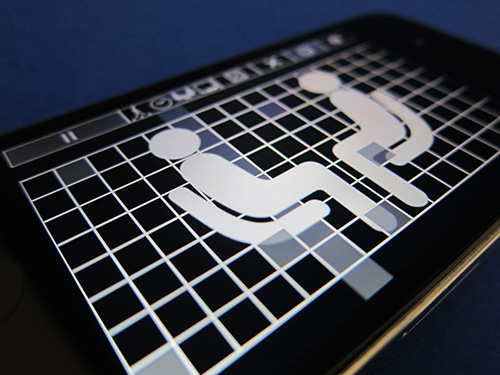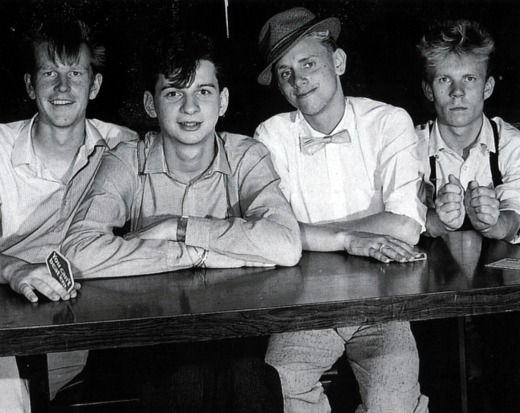In the previous installments of our interview with JM, he talked us through his time with Fad Gadget, forming Kid Montana and then the Weathermen and his work with Front 242. In this final part, Jean Marc brings right up to date as we go through the 90s and into the 21st century.
Part 4
-So you were working
with Front 242, then into the 90s you collaborated with Alain Bashung and
Julianne Regan from All About Eve (in Jules Et Jim), there seems to have been a
lot of experimentation and freedom in that period…
Well, it’s funny. I got myself a sampler an Akai s3000 in the early 90s and started doing sampling and one day I got a call from Alain Bashung –
for you English people must not mean much to you but he was the hugest rock
star in France at the time so when he called me asking me to work one song with
him and I immediately said yes. I ended up doing 5 songs with him so he really
loved what I was doing. He really pushed me to experiment with stuff and I
enjoyed that immensely. It was an experiment with him because he gave me tracks
without the vocals and without ANY indication of what the chorus was and what
are the verses and what the song is about. He also took out some instruments
and so it was a really weird experiment for me to work on something so big and which
was supposed to be still enjoyable for people in the mainstream audience. I
supposed he liked what I did because he called me two years later and asked me
to write songs for him that was even one step further. I’ve got one song on his
album Fantasie Militaire which has been voted Best French Rock Album of the
last 20 years which is kind of cool. I made some experiments with Julianne Regan from All About Eve under the Jules Et Jim name which was great also which
was more kind of … electronic pop I would say you know but it didn’t have much
success to be honest which is a shame because the songs are very good I think.
And she’s marvellous.
In the mid 90s somebody I didn’t know but was working in a
studio I did know of was asked to do the soundtrack for a game called V-Rally
one of the early car games. The producer of the game wanted something that
sounded like 9 Inch Nails. They thought of me and they called me said why don’t
you do the soundtrack for that so I did soundtrack for that. Gluing to the idea
that they wanted industrial style music like trance which I was doing at the
time. It was for Infogrammes and they hated it so they didn’t use my soundtrack
so they asked some rock band to play some hard rock music but I then started to
make soundtracks for video games and I loved that to this day I still love it.
I think it’s music complemented with images - it’s much more powerful than just
music.
-Do you approach like
a film soundtrack composer or is the process different?
It’s very different. In a game first you have to think
things will be looping. If the player has to be in one interface if he can’t
resolve the puzzle he’s going to be there for 5 minutes. So you have to think I
have to do something remarkable but at the same time the player can’t notice it
because if he notices it it’s going to distract him but at the same time it
needs to be immersive. It’s a very complex thing. It’s not like in a movie
soundtrack where you have to do things in layers which is going to be in the
background. In a video game it’s very much up front. I try to do something
which is great and at the same time I try to make it blend with the image. It’s
quite complicated but it’s a great process. I start with either playing the
game in its early form or with images from the game and then I build from that.
-Most recently you
have been working with Masayuki Akamatsu and of course the legendary Kraftwerk
keyboard and percussionist Karl Bartos on the iPhone app Minicomposer. How did
that all come together?
I had done a remix for Karl Bartos a few years ago and we
kept in contact. I went to see one of his shows which happened in Belgium two years
ago and I thought it was just brilliant. It was imaginative and at the same
time it was very nostalgic and sentimental and romantic, powerful – all the
emotions that come with Kraftwerk. I told him you should do this and do that.
He was bored of me telling him what he should do so he said, well, show me now.
So I started to work with him more closely to find gigs. Then I thought why
don’t we do a free application for iPhone. So this is how it happened … I
looked for somebody to work on it that could program the application. I found
Masayuki and we went on from that. It came out. It’s still available, still free and still fun to play!
-A final question –
what are you working on now, what are your current projects?
Well, I have got several projects coming on. I’ve got one
album which is made of cover versions which is called Leatherman with a guy
who’s more of a lyricist than a singer. It’s cover versions of songs but the
songs are totally deconstructed and played differently from the original- The Ghost & Writer project which I’m doing with a German singer. We’re
doing it the way more and more bands are doing it which is all the members of
the band are disbanded all over the internet and they send files here and
there. I send the music, he sends the vocal and then I mix the stuff.
I’m actually doing a soundtrack for a great video game which is going to come out in a few months which I’m working with classical instruments. After the early analogue synthesizers, digital synthesizers and samplers, now you have the libraries. Some libraries are amazing and I’m using one which is brilliant which allows me to play with orchestral instruments. I’m just f**king around with it. It’s really entertaining too. Sometimes it does sound a little bit like an orchestra but most of the time it’s just the sounds that you use but you use them in a way that a classical composer would never use. I am also doing a [sound track to a] movie. It’s very funny because this project is a TV movie about wildlife in Africa [so I thought] ‘What the f**k am I going to do with this? How is this going to work?’. So to start with I made some African music, High Life music, music I know and I love. I tried to do that with guitars it sounds OK to me but I thought when I try to place that on the images it doesn’t work at all. I was supposed to make music about elephants going to the river to drink or rhinoceroses at night or hippopotamuses … and it doesn’t work with High Life music like this. So I thought what am I going to do? What about if I did what Camille Saint-Saens did with the Carnival Of The Animals and I gave every animal a sound. So started working on it and I gave the rhinoceros a cello sound [from the library], the hippopotamus woodwind sounds and the elephant brass– and it works marvellously. The producer loves it, everybody loves it! I managed to get myself out of a hole I put myself in. How am I going to do music which is basically electronic in a field which is totally opposite to what I do. Wild life in Africa – how do you come from listening to Kraftwerk and Brian Eno to end up doing music for that. I don’t know! But they [the production company] love it.
Jean-Marc has put together an exclusive Spotify playlist for us that chronicles over 40 years of music including classics, influences and some key tracks from his diverse and unique back catalogue. Listen here ...I’m actually doing a soundtrack for a great video game which is going to come out in a few months which I’m working with classical instruments. After the early analogue synthesizers, digital synthesizers and samplers, now you have the libraries. Some libraries are amazing and I’m using one which is brilliant which allows me to play with orchestral instruments. I’m just f**king around with it. It’s really entertaining too. Sometimes it does sound a little bit like an orchestra but most of the time it’s just the sounds that you use but you use them in a way that a classical composer would never use. I am also doing a [sound track to a] movie. It’s very funny because this project is a TV movie about wildlife in Africa [so I thought] ‘What the f**k am I going to do with this? How is this going to work?’. So to start with I made some African music, High Life music, music I know and I love. I tried to do that with guitars it sounds OK to me but I thought when I try to place that on the images it doesn’t work at all. I was supposed to make music about elephants going to the river to drink or rhinoceroses at night or hippopotamuses … and it doesn’t work with High Life music like this. So I thought what am I going to do? What about if I did what Camille Saint-Saens did with the Carnival Of The Animals and I gave every animal a sound. So started working on it and I gave the rhinoceros a cello sound [from the library], the hippopotamus woodwind sounds and the elephant brass– and it works marvellously. The producer loves it, everybody loves it! I managed to get myself out of a hole I put myself in. How am I going to do music which is basically electronic in a field which is totally opposite to what I do. Wild life in Africa – how do you come from listening to Kraftwerk and Brian Eno to end up doing music for that. I don’t know! But they [the production company] love it.









